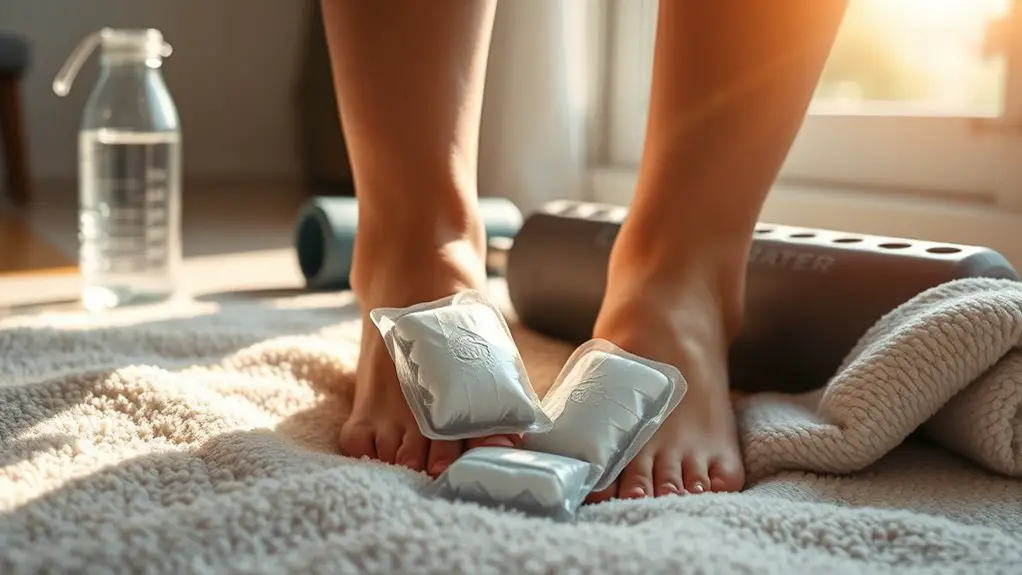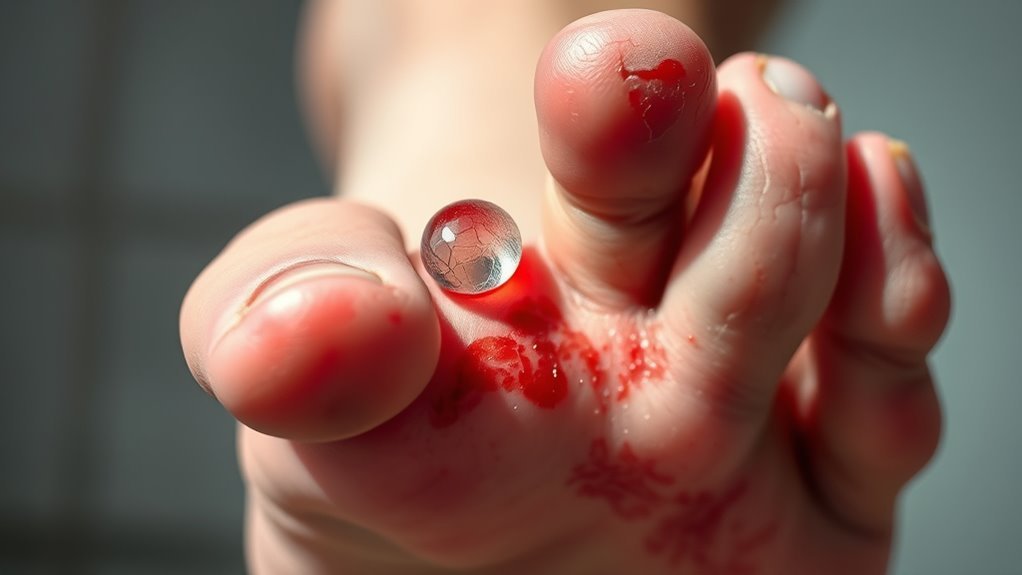The best arm care routine for pitchers combines a proper warm-up, dynamic stretching, strength training, and recovery techniques. Start with mobility exercises, like arm circles and torso twists. Incorporate specific strength training, focusing on shoulder stability and forearm strength. Don't forget recovery methods like ice therapy and compression to reduce soreness. Staying hydrated is key, too. If you pay attention to your arm health and recognize injury signs, you'll set yourself up for success on the mound. There's more to explore on how to optimize your routine!
Understanding the Anatomy of the Pitcher's Arm
When you understand the anatomy of a pitcher's arm, you can better appreciate the demands placed on it during gameplay. Your arm's muscle groups and joint mechanics work in harmony, but any muscle imbalances can lead to injury risks. The intricate network of connective tissues and tendons supports movement, making tendon health essential for performance. Understanding biomechanics principles helps you identify how flexibility factors and strength ratios affect your throwing motion.
During the recovery phases after intense pitching, it's important to pay attention to how your arm feels. Neglecting recovery can lead to long-term issues, hindering your freedom to play. By grasping these concepts, you can take proactive steps to maintain your arm's integrity. Prioritizing your arm care routine allows you to harness your potential while minimizing the risks associated with the demands of pitching. Additionally, incorporating Functional Movement Screening into your routine can help identify weaknesses that may affect your throwing performance.
Importance of a Proper Warm-Up
A proper warm-up is essential for keeping your arm healthy and injury-free. It not only helps you perform at your best but also increases your range of motion, allowing for more effective pitching. By prioritizing your warm-up routine, you're setting yourself up for success on the mound. Additionally, incorporating mobility training into your routine enhances performance and reduces the risk of injuries.
Preventing Injuries Effectively
Although many pitchers may overlook it, properly warming up is essential for preventing injuries. A solid warm-up routine not only prepares your muscles but also reduces the risk of strains and tears. Incorporating specific movements can enhance your injury prevention strategy. Here's a quick reference:
| Warm-Up Activity | Purpose |
|---|---|
| Dynamic Stretching | Increases blood flow |
| Arm Circles | Mobilizes shoulder joints |
| Band Exercises | Strengthens rotator cuff |
Enhancing Performance Levels
Warming up isn't just about injury prevention; it's also a key factor in enhancing your performance levels on the mound. A proper warm-up can boost your performance metrics and set you up for success. Here's how to make the most of your warm-up:
- Dynamic stretches: Engage your muscles and improve blood flow.
- Throwing progression: Start with short, easy throws and gradually increase intensity.
- Strength exercises: Incorporate light resistance training to activate key muscle groups.
- Mental focus: Visualize your pitches and game strategies to prepare mentally.
Increasing Range of Motion
Proper warm-ups play an essential role in increasing your range of motion, which can greatly enhance your pitching performance. Incorporating mobility drills and flexibility training into your routine can make a significant difference. It's all about preparing your body to be free and fluid during the game.
Here's a simple table to help you integrate effective exercises into your warm-up:
| Exercise | Purpose |
|---|---|
| Arm Circles | Improve shoulder mobility |
| Dynamic Stretching | Enhance overall flexibility |
| Band Pull-Aparts | Strengthen rotator cuff |
| Torso Twists | Increase spinal rotation |
Dynamic Stretching Exercises
To guarantee your arm is ready for the demands of pitching, incorporating dynamic stretching exercises into your routine is essential. These dynamic warm-ups not only enhance your flexibility but also prepare your muscles for the intensity of your workout. Here are four effective dynamic stretching exercises you can include:
- Arm Circles: Swing your arms in small circles, gradually increasing the size to warm up your shoulder joints.
- Torso Twists: Stand with feet shoulder-width apart and rotate your torso from side to side, promoting flexibility in your trunk.
- High Knees: Jog in place while bringing your knees up towards your chest, engaging your hip flexors and increasing blood flow.
- Shoulder Passes: With a resistance band or towel, stretch your arms out to the sides and pass it overhead to open up your shoulders.
Incorporate these flexibility drills to keep your arm healthy and ready to pitch! Additionally, proper warm-ups and stretching are crucial for preventing injuries to ensure your arm remains strong during the pitching season.
Specific Strength Training for Pitchers
Since building strength is essential for pitchers, focusing on specific exercises can considerably enhance your performance and reduce the risk of injury. Targeting shoulder stability and forearm strength will not only improve your throwing mechanics but also help you maintain your arm health. Incorporate these exercises into your routine for best results:
| Exercise | Focus Area |
|---|---|
| Shoulder External Rotation | Shoulder Stability |
| Wrist Curls | Forearm Strength |
| Scapular Retraction | Shoulder Stability |
Additionally, exercises like Farmers Walk can significantly boost your forearm strength and grip stability, which are crucial for effective pitching.
The Role of Resistance Bands
Incorporating resistance bands into your arm care routine can further enhance your strength training efforts. These tools are versatile and can provide significant benefits of resistance that traditional weights might not. Here's how resistance band exercises can boost your performance:
- Improves shoulder stability: The bands engage the smaller muscles, helping to stabilize your shoulder joint.
- Enhances flexibility: You can use bands to stretch your arm muscles, promoting a greater range of motion.
- Increases endurance: Resistance bands allow for high-rep workouts, building muscle endurance essential for pitchers.
- Portable and convenient: They're easy to carry, meaning you can work out anywhere, anytime. Additionally, incorporating multiple muscle groups in your routine can lead to enhanced overall strength and performance.
Incorporating Plyometrics
While many pitchers focus on strength training, adding plyometrics to your routine can greatly enhance your overall performance. Plyometric exercises are designed to develop your power and speed through explosive movements. These drills, like box jumps or medicine ball throws, release your full athletic potential, allowing you to generate more force with each pitch.
Incorporating plyometrics into your regimen not only improves your strength but also enhances your reaction time and coordination. When you train your muscles to contract rapidly, you can deliver pitches with increased velocity and accuracy. Plus, these dynamic workouts keep your training fresh and exciting, breaking the monotony of traditional strength sessions. Additionally, plyometrics emphasize the stretch-shortening cycle, which is crucial for maximizing explosive power and efficiency in your movements.
Recovery Techniques: Ice and Compression
After a hard outing, using ice and compression can be game-changers for your arm recovery. You'll want to explore different ice application methods to find what works best for you, along with understanding the benefits of compression. Together, these techniques can help reduce inflammation and speed up your healing process.
Ice Application Methods
When you're looking to enhance your recovery routine, mastering effective ice application methods can make a significant difference for pitchers. Ice pack techniques can help reduce inflammation and alleviate soreness, allowing you to feel free and ready to pitch again. Here are some effective methods to contemplate:
- Direct Application: Apply an ice pack directly to the shoulder or elbow for 15-20 minutes.
- Ice Massage: Freeze water in a cup, peel back the top, and massage the ice directly onto sore spots.
- Contrast Therapy: Alternate between ice and heat to promote blood flow and recovery.
- Cold Compression Wraps: Use wraps that combine cold therapy benefits with gentle compression for maximum effect.
Incorporating these methods can truly enhance your arm care routine!
Benefits of Compression
Building on effective ice application methods, incorporating compression into your arm care routine can further enhance recovery. Compression's benefits are significant; it helps reduce swelling and soreness, allowing you to bounce back quicker. When you apply compression, you're promoting enhanced circulation throughout your arm, which means better blood flow to the muscles and tissues that need it most. This improved circulation aids in delivering essential nutrients and oxygen for healing, helping you feel more energized and ready for your next outing. Plus, compression gear is often easy to wear during or after your workouts, giving you the flexibility to recover on your own terms. So, embrace compression as a crucial part of your arm care strategy!
The Importance of Hydration
Although many pitchers focus on their throwing mechanics and strength training, hydration often gets overlooked, yet it's essential for peak performance. Staying properly hydrated guarantees you maintain your energy levels, avoid cramping, and support overall recovery. Here are some effective hydration strategies to take into account:
- Drink Water Regularly: Make it a habit to sip water throughout the day, not just during practices or games.
- Electrolyte Balance: Incorporate sports drinks or electrolyte tablets to replenish minerals lost through sweat.
- Pre-Game Hydration: Start hydrating at least two hours before your game to guarantee peak performance.
- Monitor Urine Color: Use urine color as a quick check; clear or light yellow indicates you're well-hydrated. Additionally, pay attention to thirst signals as they indicate your body's need for fluids.
Monitoring Arm Health and Signs of Injury
Staying hydrated is just one piece of the puzzle for pitchers; monitoring arm health is equally important. You want to release your full potential on the mound, but ignoring warning signs can lead to serious setbacks. Pay attention to arm fatigue—if your arm feels heavy or sore, it's time to reassess your workload.
Be on the lookout for injury symptoms like sharp pain, swelling, or a decreased range of motion. These can signal that your arm's in trouble, and pushing through can make things worse. Trust your instincts; if something feels off, don't hesitate to take a break or consult a professional. Additionally, understanding the importance of regular self-assessments can significantly aid in recognizing early signs of potential injury.
Regular self-assessments and open communication with coaches and trainers can help keep your arm in peak condition. Remember, your freedom to play the game you love depends on how well you take care of your most valuable asset—your arm.
Creating a Personalized Arm Care Routine
As you develop your personalized arm care routine, it is crucial to take into account your unique needs and pitching style. Tailoring it to match your personal goals and individual preferences will help you stay healthy and perform at your best. Here's a quick guide to get you started:
- Assess Your Needs: Identify any areas of weakness or past injuries that require special attention.
- Incorporate Stretching: Focus on dynamic stretches and mobility exercises that suit your body mechanics.
- Strength Training: Choose exercises that target shoulder stability and arm strength, like resistance band workouts, as enhanced endurance can improve your pitching performance.
- Recovery Techniques: Experiment with tools like foam rollers, ice baths, or massage to find what helps you recover best.
Frequently Asked Questions
How Often Should Pitchers Perform Their Arm Care Routine?
When it comes to how often you should perform your arm care routine, daily frequency is key for maintaining ideal health. However, you might want to take into account seasonal adjustments based on your training intensity and game schedule. During the off-season, you may find it beneficial to scale back slightly, while in-season, sticking to a consistent daily routine can help prevent injuries and keep your arm in top shape. It's all about finding what works for you!
What Age Is Appropriate to Start Arm Care Routines?
Imagine a young tree, its branches reaching for the sky. Just like that tree, you can start nurturing your arm care routine in youth training—ideally around age 8 or 9. This early foundation's essential for injury prevention, helping you grow strong and resilient. You'll find freedom in movement as you develop good habits. So, embrace those practices early, and watch your skills flourish like the tree, unburdened and reaching new heights.
Can Non-Pitchers Benefit From an Arm Care Routine?
Absolutely, you can benefit from an arm care routine even if you're not a pitcher. Strengthening your arms can enhance your overall performance in various sports, whether it's baseball, basketball, or even weightlifting. Incorporating exercises focused on arm strength helps with injury prevention too, reducing the risk of strains or overuse injuries. So, if you want to stay active and pain-free, focusing on arm care's a smart move!
How Do I Know if My Routine Is Effective?
You'll know your routine's effective by tracking specific effectiveness metrics like strength, range of motion, and recovery time. If you're noticing improvements in these areas, it's a good sign. However, don't hesitate to make routine adjustments if you feel any discomfort or stagnation. Listen to your body—it knows best. Embracing this freedom allows you to tailor your approach, ensuring you're not just going through the motions, but truly progressing.
What Are Common Misconceptions About Pitcher Arm Care?
When it comes to pitcher arm care, a few common misconceptions can trip you up. For instance, many believe that overtraining is a sign of dedication, but it can actually lead to injuries. You might also think flexibility isn't that important, but it plays an essential role in preventing strains. Embracing a balanced approach and understanding these myths can give you the freedom to pitch with confidence and care for your arm effectively.




